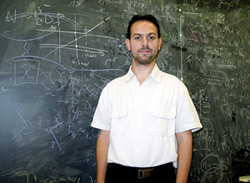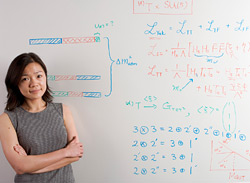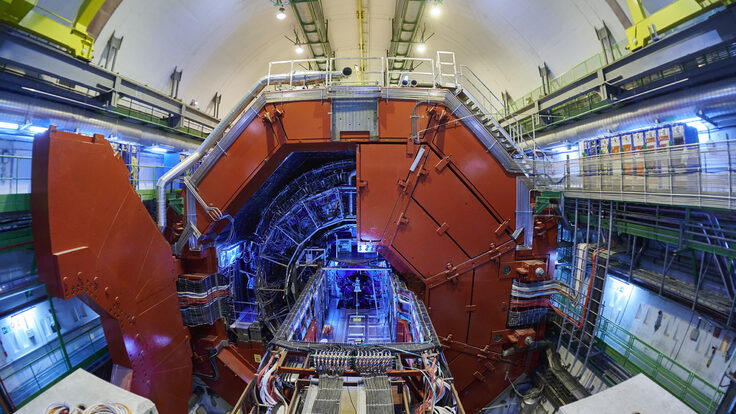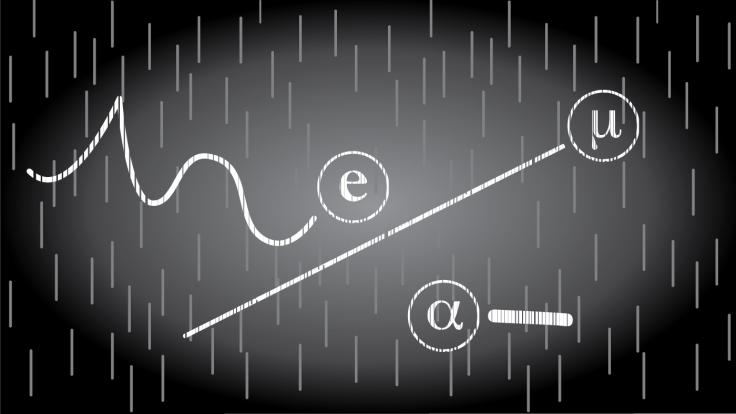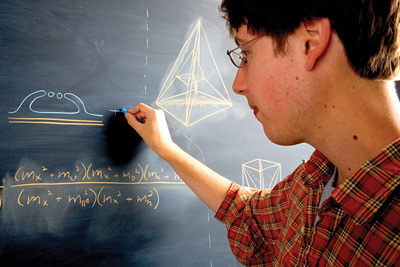 |
Talk AND chalk Swimming against the cultural tide, physicists–especially theorists–cling to their blackboards. by Heather Rock Woods |
| Photos: Fred Ullrich, Fermilab | |
Theorists cant help it: When asked to explain something, they reach for a piece of chalk. The language of math and physics seems to require a writing implement and a large vertical surface.
For two centuries, scientists have turned to blackboards to grapple their thoughts into coherent equations and to intellectually commune with like-minded people. You cant describe supersymmetry by waving your hands. You cant quickly draw a magnet layout for a student using a graphics program.
While the world at large is converting to whiteboards, the iconic blackboard still holds a fond and prominent spot wherever theoretical physicists gatherin hallways, auditoriums, and meeting rooms of old buildings and new.
"A lot of what theorists do is very creative. We need to talk and interact with each other. Drawing diagrams is a very efficient way to communicate," says JoAnne Hewett, a theorist at the Stanford Linear Accelerator Center.
Boards are also useful for tracking experimental nuts and bolts, says Giorgio Chiarelli, a staff researcher at INFN Pisa in Italy, who recalls his student days "explaining my work to my supervisor with sketchy description, and being covered with white chalk at the end."
When Chiarelli moved to a newer building outfitted with whiteboards, he and his officemate Sandra Leone used the board to keep track of the silicon detectors they were building. "It was nice to see, every day, the job being done," Chiarelli says, adding, "Some of us still have old chalkboards saved from modernization. Sometimes I envy them. It was black elegance."
Hardly endangered
In the office world, theres no question whiteboards have taken over. Schools, as well, have been switching to whiteboards, partly to prevent chalk dust from damaging the computers now common in classrooms. Overall, marker boards outsell blackboards by three to one, according to Pat Donohue, owner of Aywon, a company in Hazelton, Pennsylvania, that manufactures and sells both. Even the academic sector has gone largely to whiteboards. "Our biggest market for chalkboards," Donohue says, "is restaurants that want chalkboard menus."
But with their smelly markers and spotty erasing performance, whiteboards have won few converts among theorists at SLAC. When the group needs new boards apparently they do wear out after 40 yearsit still requisitions blackboards.
On one typical afternoon, the theory floor is quiet just before a seminar. A graduate student microwaves her lunch, while two young men animatedly talk and draw on the aluminum-trimmed greenboard in the break area. A few steps away, the "fish tank"a theorists work room is dark, until theorist Tom Rizzo switches on the lights. The front wall of the fish tank is glass, while blackboards cover the three remaining walls from ceiling to below knee height "so we dont have to keep erasing," he says. The boards come in handy during phone conferences with far-flung theory groups when debating fine points for a joint paper.
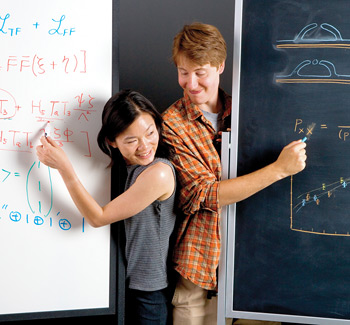 |
| Theoretical physicists Mu-Chun Chen and Jack Laiho are on opposite sides of the Great Board Divide. Chen, an assistant professor at UC-Irvine, is a recent convert from chalk to marker; Laiho, a postdoc at Fermilab, is a blackboard fan, "because I like the texture of the chalk, and because the chalkboards are easier to erase if you leave them for a long period of time." He adds, "The sound of fingernails on the chalkboard doesnt bother me so much" as it does some people. |
White and pink jumbles of symbols, numbers, and squiggles fill the boards. "Theres a gravity thing," says Rizzo, pointing. Then, working clockwise around the room: "This is stringy stuff, and this is Michaels writing," referring to Michael Peskin, head of the theory group. "Its very distinctive."
Thousands of miles away, at the three-year-old building that houses the Perimeter Institute for Theoretical Physics in Waterloo, Canada, blackboards line one wall of each office, lounge, auditorium, and even the institutes Black Hole Bistro. "Coffee and blackboards and leather couchesit all fits together," says John Matlock, director of communications for the institute. "Our 60 scientists and 300 visiting researchers are all chalk-oriented."
And when the Fermilab Theoretical Astrophysics group moved offices two years ago, the group lobbied to have blackboards at their new location in Wilson Hall. "On our old floor, most offices had floor-to-almost-ceiling blackboards. A number of people, including myself, considered this something of a signature of Fermilab," says theorist Albert Stebbins. Perhaps blackboards near the floor werent ergonomically correct, he says, but "stuff you wrote there had a very long lifetime." And theres the nostalgia factor: Blackboards, he says, are "more historically relevant."
Elsewhere in Wilson Hall, the whiteboard that replaced a 30-foot-long blackboard in the largest meeting room performed poorly. Intended to serve both as a writing surface and a projection screen, the whiteboard didnt reflect images well, and its vertical seams immediately became stained with ink. "Then an errant Sharpie [permanent marker] drifted into the room," adds Fred Ullrich, manager of Visual Media Services at the lab. The whiteboards were removed, and the wall is now covered with blackboard paint.
There are other practical reasons why theorists cling to their chalk.
"With a chalk board you always know how much gas there is left in the tank for discussion," says Michelangelo Mangano, a theorist at CERN, the European particle physics lab near Geneva. "With the whiteboard felt pens you always run out of ink without warning right in the middle of your equation! Last, but not least, blackboards are typically 10 times larger than whiteboards, and real estate is one of the primary needs in a serious board discussion."
For physicists in particular, says Donohue of Aywon, "I think theres a psychological thing to erasing with the back of their hand, and rewriting with the same hand. You cant do that with marker board without washing your hands after."
And for some reason, blackboards seem to invite conversation. Before wall-filling blackboards were replaced with whiteboards in parts of Wilson Hall, "I saw a lot more activity and conversations by the blackboards," says Ullrich. "People were fully engaged in a conversation without a lot of words saidit was fascinating to me."
You say blackboard, I say whiteboard
The marker vs. chalk debate has been going on since whiteboards made their debut in the 1980s. Chalk doesnt stink, but markers dont shed dust that can damage electronics and irritate eyes and lungs. On the other hand, 18 marker ink leaves a gummy, hard-to-clean residue and can stain boards and clothing. Marker ink is brighter but runs dry, while chalk breaks and disappears. While you can project images on whiteboards, the results are not ideal. When it comes to erasing, the argument ends in a draw: Each side claims its type of board is better.
Blackboards started as handheld slates, found in oneroom schoolhouses where paper and pencils were scare and expensive. Scotsman and geography teacher James Pillans essentially put those small slates together on a wall to make the first blackboard. This revolutionary education technology spread abroad in 1801, when the first American teacher to use a blackboard taught math lessons at the United States Military Academy at West Point, New York. For the remainder of the century, trains delivered slate blackboards to schoolhouses around the country.
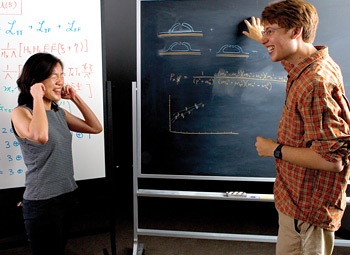 |
By the 1960s, boards made of slate became too expensive. Nowadays, both white and chalk boards are commonly made from high-temperature liquid porcelain fused onto steel. Blackboard surfaces are coated with a grainy finish thats rough enough for the chalk to grip. Marker boards dont need additional finishes. Blackboard paint contains added sand or grit, but this surface wears down quickly.
Once made of sedimentary rock, chalk sticks are now made from calcium sulfate (gypsum) or calcium carbonate (a form of limestone). Chalk dust is not considered toxic, " but it can be a respiratory irritant to those with lung disease such as asthma," says Dr. Katherine Duvall of the Health and the Arts Program at the University of Illinois at Chicago. Although Dr. Carol Conrad, who specializes in pediatric pulmonary medicine at Lucile Salter Packard Childrens Hospital, says chalk dust particles are big, and therefore unlikely to get into the small airways where asthmatics experience problems, there is no consensus on whether it can cause respiratory problems or aggravate asthma. Low-dust versions of chalk have been around since 1902, when Binney & Smith (now Crayola) created it for schools.
Toxicologists, including a group at Duke University Medical Center working for the Art & Creative Materials Institute, a nonprofit trade association, evaluate art materials such as chalk and whiteboard markers. If found safe, materials receive an "AP nontoxic" or "conforms to ASTM D4236" label. Just because a marker smells bad does not necessarily mean the fumes are toxic; but when it comes to health effects, Duvall says water-based markers are safer than those containing alcohol, which in turn are better than those with aromatic hydrocarbons.
Is the future clear?
While the choice between blackboard and whiteboard seems to be mostly a matter of personal preference and group tradition, astrophysics researchers at Oxford University have moved to a new frontier: They draw on the glass walls of their offices.
"We have small whiteboards adhered to the glass. However, some people just write on the glass directly, because there is much more space," says Brad Johnson, a postdoctoral researcher there. "I personally think it makes the environment look interesting. You can see what people are working on, and all of the Greek symbols and math equations are almost artistic."
His colleague Pedro Ferreira, an Oxford lecturer and research fellow, enjoys the scene as well: "A few years ago someone brought in some wonderful fluorescent pens that really stand out. So some offices have a mixture of sketches, equations, phone numbers, and silly haiku."
The new Kavli Building for Particle Astrophysics and Cosmology at SLAC has an opaque glass partition separating the collaboration space from the stairwell. Markers and an eraser sit in a small container nearby, so when theorists and experimentalists start discussing an issue, they can draw on the wall, which for a time was graced with British postdoc Phil Marshalls directions for making tea.
Is glass the future? Perhaps, but there are other developments in the works, as well. Regular blackboards and marker boards can now be made with porcelain thats free of heavy metals, making their disposal more environmentally friendly, says Donohue, whose company has been producing boards this way for more than half a year.
In addition, there are computer-compatible boards regular writing surfaces with sensors that record whats written and send it to a computer, allowing equations, homework assignments, and drawings to be saved and shared. Although theyre still quite expensive, Donohue says, sales "are growing by leaps and bounds." Just dont expect a theorist to use one.
The blackboards at Fermilab are the creation of genius. I don’t know who thought of the idea of floor-to-ceiling blackboards, but the wall in my office has by now become a vital organ, an extension of my mind. I am eternally grateful to the building manager who installed those. If the idea of replacing them with whiteboards should ever cross my mind, it would be a thought filled with horror.
More proper and lasting When it came time to order furniture for my new office, I chose a whiteboard. The whiteboard makes me write better, probably because the presentation on the whiteboard feels more proper and lasting (of course it becomes truly permanent if you don’t clean it soon enough.) This consequently makes me think in a more organized fashion. In addition, because of the much more vivid colors and the better contrast of the markers compared to chalk, things written on the whiteboard can be visualized more easily and they leave much deeper imprints. All of these may facilitate the creative processes in a subtle way. |
Click here to download the pdf version of this article.



